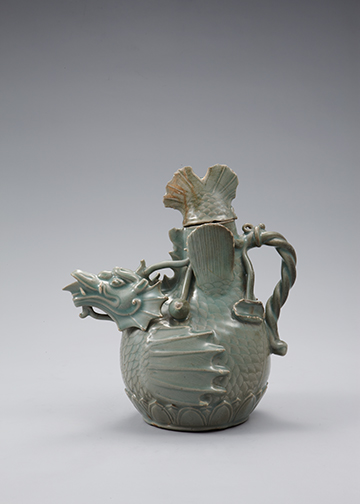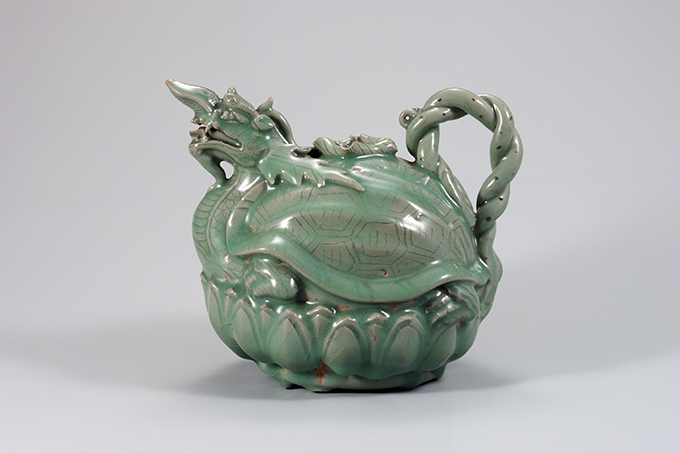- Date 2019-02-22
- Hit 3649
The Goryeo Dynasty (718-1392) saw many magnificent achievements in arts and culture, perhaps epitomized by Goryeo celadon, which flourished during the era. After China, Goryeo was the second country in the world to produce celadon. But beyond merely following the style of Chinese celadon, Goryeo celadon developed its own unique aesthetics, with colors, decorative techniques, patterns, and shapes that were quite distinct from those of Chinese celadon. In particular, the true artistry and elegance of Goryeo celadon can be seen in sanghyeong celadon vessels, which are sculpted in the forms of people, animals, or plants. Coated in luminous jade-colored glaze, these charming and resplendent treasures combine the beauty of artworks for appreciation with the function and practicality of household implements.
In the early Goryeo period, most celadon objects were ordinary vessels used to serve or store food and drink, such as teabowls and dishes. But with the increase in both quality and demand, Goryeo celadon culture rapidly changed and expanded. By the mid-Goryeo period, celadon objects had become much more diverse in terms of their types, shapes, decorative techniques, and motifs. Moreover, this period also saw the development of the distinctive jade-colored glaze that is now characteristic of the peak period of Goryeo celadon. In addition to household vessels, celadon was used to produce an array of different objects, including ritual implements (e.g., incense burners), stationery items (e.g., water-droppers and inkstones), furniture (e.g., chairs), and building materials (e.g., bricks and roof tiles). Among these items, sanghyeong celadon vessels shaped like people, animals, or plants, were widely produced.
Celadon Dragon-shaped Ewer (National Treasure 61)

As one of the representative sanghyeong celadon vessels, this dragon-shaped ewer features a unique shape, meticulous details, and gorgeous glaze color. Above all, it showcases the creativity and technological advancement of the Goryeo people, who elaborately visualized a mythical creature with the head of a dragon and the body of a fish. The entire vessel is shaped like the creature, highlighted by the protruding dragon head, with its wide eyes staring gallantly ahead and its open mouth serving as the ewer’s spout. The frills and fins are dynamically spread around the curled body, while the tail points straight up to the sky. A lotus stem hangs down over the head, where two dots of iron-brown pigment represent the eyes, instilling the piece with a lifelike sense of vitality. The sharp fangs are painted with white slip, creating an impressive contrast against the glaze. The round body, which is incised with a regular pattern of semi-circles to represent the scales, conveys a nice sense of tension. The natural accumulation of glaze in the open areas of the design results in areas of deeper color, adding to the overall sense of mystery. The base is densely decorated with lotus petals, recalling the lotus pedestals that often support dragons in Buddhist sculptures. Attached to the back of the body is a twisted lotus stem that serves as the ewer’s handle, showing that the ceramist emphasized the overall décor of the ewer over practicality.
Produced in the mid-Goryeo period, this ewer causes us to imagine the mythical dragon-fish creature dramatically leaping out of the water, with a U-shaped body and raised tail fin. This motif of a leaping dragon-fish is believed to have been popularized during China’s Liao Dynasty (916-1125). In fact, this ewer resembles a Liao carp-shaped ewer with tri-colored glaze (Zhongjing Museum in Ningcheng County), along with various other ewers excavated from Inner Mongolia. As such, this ewer provides compelling evidence of the cultural exchange that was conducted between Goryeo and Liao. The influence of Liao aesthetics on Goryeo crafts can be attributed to the import of Liao crafts via trade, which began by at least the late eleventh century. Also, records show that, during the reign of King Hyeonjong (顯宗, r. 1009-1031), Liao artisans began to settle in Goryeo, where they helped to produce metal wares and fabrics.
Celadon Turtle-shaped Ewer (National Treasure 96)
Another representative example of a sanghyeong celadon vessel is this turtle-shaped ewer sitting on a lotus pedestal. The head resembles a dragon, with a large pointed nose and a backwards horn on the top. The head is slightly raised with an open mouth, as if the creature is belting out a magnificent roar. The eyes are represented by two dots of iron-brown pigment, adding a touch of realism to the mythical creature. Enhancing the realistic depiction, the fangs, other teeth, and tongue are fully expressed inside the mouth. The creature has the body of a turtle, with a hexagonal turtle-shell motif incised on the shell. Incised within each hexagon is the Chinese character “wang” (王), which means “king.” There is a hole on the top of the shell, encircled by a lotus leaf decoration, and four large feet below the shell, complete with sharp claws. Overall, the creature is rendered in astonishing detail, down to the tiny scales and wrinkles on its feet, showcasing the adroit skills of the Goryeo celadon craftspeople.

Like the dragon-shaped ewer, the turtle sits atop a lotus pedestal and has a handle shaped like a twisted lotus stem attached to the back. Notably, the motif of a turtle perched on a lotus pedestal is commonly seen in steles from the Goryeo period. This motif can be interpreted in the context of Buddhism, which had a strong influence on the development of Goryeo celadon. In particular, the dragon-turtle on a lotus pedestal is interpreted as a symbol of rebirth from a lotus (蓮花化生), while the “王” character (“king”) that appears within each hexagon represents the belief that the Goryeo king was the manifestation of Buddha (王卽佛). Overall, motifs of mythical creatures—including dragons, dragon-fish, dragon-turtles, and “nine-dragons”—express the divinity and authority of the royal court as a supernatural and sacred entity.
Sanghyeong Celadon and Jade-colored Glaze
The twelfth and thirteenth century are typically considered to be the golden age of Goryeo celadon production. Not coincidentally, this period is also characterized by the wide production of sanghyeong celadon vessels, which were sculpted to resemble people, animals, and plants. These alluring vessels can be roughly divided into two categories: the natural and the religious. The natural motifs generally consist of animals and plants that were familiar from daily life in Goryeo. For example, many bottles, ewers, water-droppers, and incense burners were shaped like mandarin ducks, ducks, chamoe (Korean melons), bamboo shoots, and gourds.
On the other hand, the religious motifs are primarily related to Buddhism, Goryeo’s state religion. Examples include celadon sculptures of Buddha, bodhisattvas, and arhats, along with vessels decorated with sculptural renderings of lotus flowers and plants. In particular, lotus petals were a favored motif on ritual implements (such as incense burners), as well as on household items, such as bowls and plates, which often used widely flared mouths to convey the full bloom of the lotus.
Although not as ingrained as Buddhism, Taoism still had considerable influence in the Goryeo royal court, particularly during the reign of King Yejong (睿宗, r. 1105-1122), as documented in the “Miscellaneous Rites” section (雜祀條) from the “Rituals” chapter (禮志) in History of Goryeo (高麗史). Reflecting this background, sanghyeong celadon vessels with Taoist motifs were also produced, including an ewer shaped like a Taoist immortal holding a peach, and incense burners and water-droppers shaped like peaches, monkeys, qilin, and phoenix.
Goryeo sanghyeong celadon vessels typically highlight the characteristic features of their respective forms, such that they can actually convey a stronger impression than the natural items themselves. Significantly, these vessels were sculpted entirely by hand, distinguishing them from similar Chinese ceramic vessels, which were usually shaped with a mold. Thus, as compared to their Chinese counterparts, Goryeo sanghyeong vessels tend to be more vibrant and realistic, with more elaborate details that are accentuated by the translucent jade-colored glaze. These vessels represent the absolute pinnacle of Goryeo celadon, when the color of the glaze and the unique shape of the vessel were the two points of emphasis. From this point forward, the aesthetic style shifted to focus on more conspicuous decorations, such as inlay and iron-brown underglaze.






 X
X  Facebook
Facebook 